Japanese Architecture
1/76
There's no tags or description
Looks like no tags are added yet.
Name | Mastery | Learn | Test | Matching | Spaced |
|---|
No study sessions yet.
77 Terms
Japanese Architecture
A synthesis of ideas from China and native conditions producing a distinct style characterized by lightness, delicacy, and refinement.
Wood Construction
Traditional Japanese buildings were primarily made of wood due to the abundance of timber and its earthquake resistance.
Island Nation
Japan's geographic isolation allowed for a unique architectural style while absorbing influences from trade, particularly from China and Korea.
Mountainous Terrain
Over 70% of Japan's land is mountainous, influencing urban planning and the adaptation of structures to natural landscapes.
Earthquake-Prone
Japan's location on the Pacific Ring of Fire necessitated architectural innovations focused on flexibility and resilience.
Volcanic Activity
Japan's geology influenced construction materials and city layouts, utilizing lava stones and adapting to dynamic terrain.
Hot Springs
The presence of natural hot springs led to the development of onsen architecture, emphasizing harmony with nature.
Seasonal Extremes
Japan's varied climate required architecture that adapts to both humid summers and cold winters.
Machiya
Traditional wooden townhouses found throughout Japan, especially in Kyoto.
Minka
Vernacular houses constructed in various traditional Japanese styles, known as "houses of the people."
Typhoons
The risk of typhoons influenced the design of sturdy structures with heavy roofs and overhanging eaves.
Rainfall
Japan's high humidity and heavy rainfall have affected building materials and design. The use of elevated platforms (engawa) and large, sloping roofs helps protect buildings from water damage.
Nara and Heian Periods
Early Japanese architecture was heavily influenced by Chinese styles, particularly during the establishment of Buddhism.
Feudal Period
Characterized by the prominence of samurai and the development of castle architecture for defense.
Edo Period
Marked by the rise of machiya and sukiya-zukuri, emphasizing elegance and natural materials.
Modern Period
Post-Meiji Restoration, Japan incorporated Western techniques while blending modernity with traditional aesthetics.
Shintoism
Japan's indigenous religion influencing architecture, particularly in shrine design emphasizing simplicity and harmony with nature.
jinja
the design of shrines
Shinto architecture
emphasizes simplicity, harmony with nature, and the use of natural materials such as wood.
Torii Gate
An iconic symbol of Shinto architecture marking the entrance to sacred spaces.
The torii of Itsukushima (Miyajima) Shrine
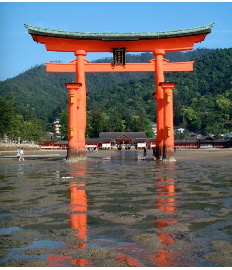
Shimmei-zukuri
A style of Shinto shrine embodying the original style of Japanese building.
Honden
The most sacred building at a Shinto shrine, intended for the enshrined kami.
Munakata Grand Shrine
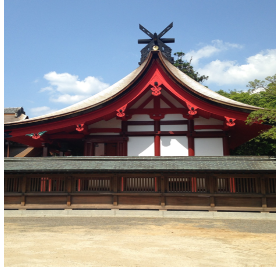
Ise Jingu
A Shinto shrine complex consisting of the Outer Shrine (Geku) and Inner Shrine (Naiku).
Geku
Outer shrine which is dedicated to Toyouke, the Shinto deity of clothing, food and housing.
Naiku
Inner Shrine, which enshrines the most venerated deity Amaterasu, the Sun Goddess.
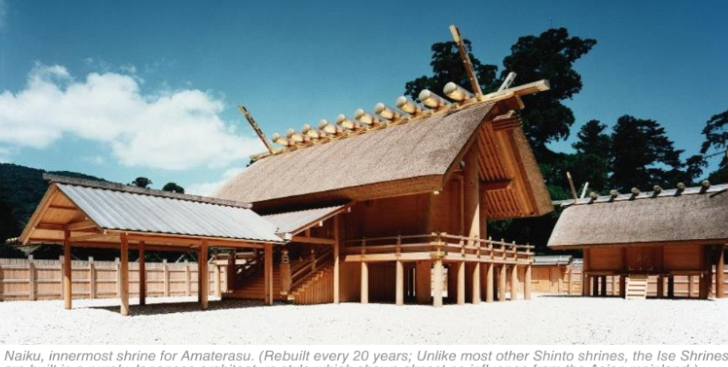
Shikinen sengu
the ritual process of rebuilding the Ise every twenty years.
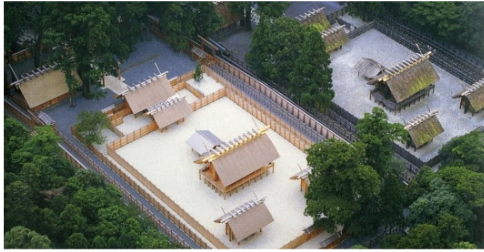
Itsukushima Shrine
Hiroshima Prefecture. (UNESCO World Heritage Site)
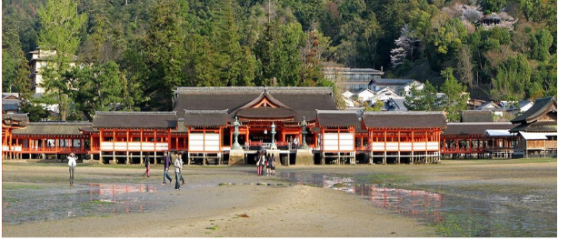
Izumo Taisha
(Shimane Prefecture) Characterized by a raised floor and thick wooden columns, reflecting early Japanese architecture before the influence of Buddhism.
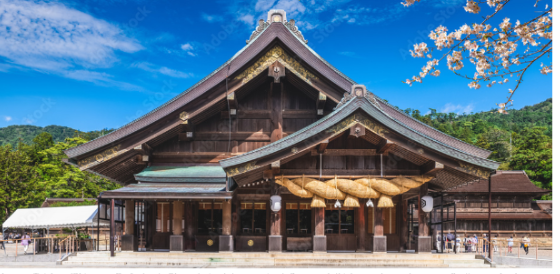
Shinbutsu-shūgō
The syncretism of Shinto and Buddhism that was Japan's main organized religion until the Meiji period.
Himeji Castle
A UNESCO World Heritage Site and classic example of Japanese castle architecture.
Zen Buddhism
in paritcular, influenced minimalist architecture and the creation of serene spaces like the rock garden.
Kodo
assembly hall for monks for reading sacred texts.
To
Japanese pagoda enshrining Buddha relics.
Kondo
Golden Hall; sanctuary where the main image of worship is kept.
Chumon
inner gateway to the precinct.
Kairo
covered gallery surrounding the precinct.
Sorin
crowning spire on a Japanese pagoda.
Horyuji Temple, Nara
One of the oldest surviving wooden buildings in the world; Oldest existing temple complex in Japan
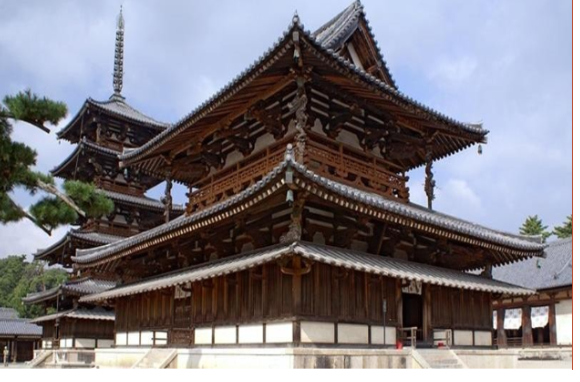
To
Japanese pagoda, also butto or toba.
Central structure of a Buddhist compound.
The Serene Temple of Silver Pavilion
Kyoto (Ginkaku-ji). Formally referred to as Jisho-ji. Designated by UNESCO as World Herritage Site in 1994, and an official National Treasure of Japan
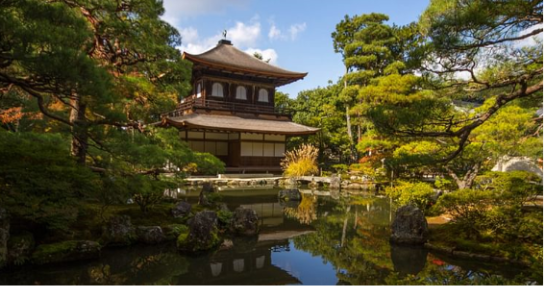
The Golden Pavilion, Kyoto
(Kinkaku-ji; Built by Ashikaga Yoshimitsu, a Zen Temple.)
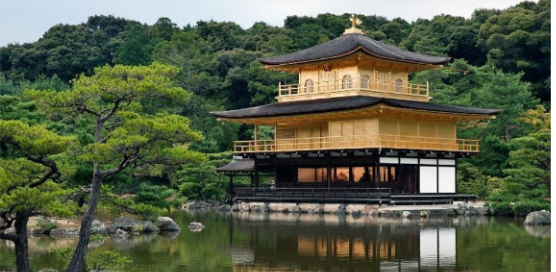
Todai-ji Temple (“Great Eatern Temple”), Nara
. Constructed during the Nara period (8th century), it is famous for housing the Great Buddha (Daibutsu) statue.
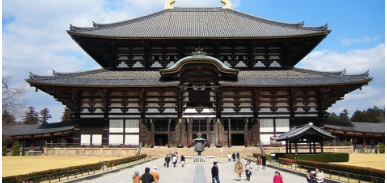
Karensansui
Japanese Rock Garden
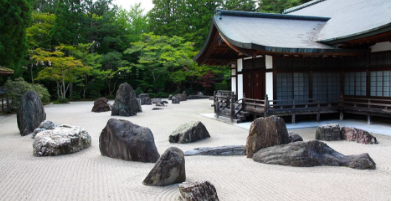
Syncretism
Many buildings in Japan, particularly shrines and temples, show a blend of Shinto and Buddhist elements, reflecting Japan's syncretic religious history.
Shinbutsu-shūgō
Also called Shinbutsu-konkō
Is the syncretism of Shinto and Buddhism that was Japan's main organized religion up until the Meiji period.
Himeji Castle
(also know as White Heron Castle) - Hyogo Prefecture. The largest castle in Japan, with over 80 original buildings with numerous walkways and courtyards connecting them. A UNESCO world Heritage Site.
Completed in 1609, it is a classic example of Japanese castle architecture. The complex multi-layered

Matsumoto Castle. Nagano (Matsumoto-jo or “Crow Castle”)
Designated as National Historic Site of Japan in 1930. One of the original 12 castles in Japan.
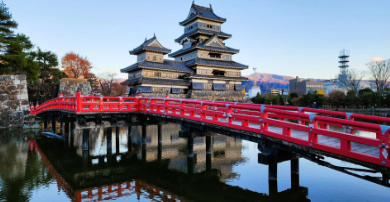
Shinden-zukuri
A style of architecture from the Heian period characterized by open layouts and large gardens.
Heian Imperial Palace
Kyoto. Sample of Shinden-zukuri Style
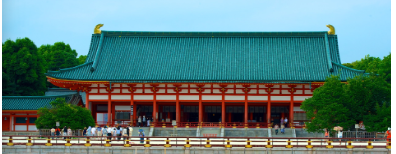
Tatami
Straw mats used as floor coverings in traditional Japanese homes.
Fusuma
Traditional Japanese room separators made of paper or cloth in wooden frames.
Shoji
Translucent paper room dividers and windows in a wooden lattice frame.
Ken
A linear unit for regulating column spacing in traditional Japanese construction.
Wooden Construction
The primary material in Japanese architecture, especially hinoki, due to its flexibility and earthquake resistance.
Complex Joinery Techniques
Traditional carpentry methods that avoid nails, using intricate wood joints for flexibility and durability.
Minimalist Ornamentation
Influenced by Zen aesthetics, emphasizing simplicity and natural materials in decoration.
Pagodas
Architectural structures symbolizing the five elements in Buddhism.
Komainu
Stone or bronze guardian statues found at Shinto shrine entrances, meant to ward off evil spirits.
Shoin
Meaning "writing hall."
A new type of residential architecture
Features the proportioning system of using tatami mats (about 1x2 yards in size).
Chashitsu
Teahouses
Venue for tea ceremony
Roji, ornamental garden adjacent to the teahouse.
Ken
A linear unit for regulating column spacing in traditional Japanese construction. Initially equal to 6 shaku (1.818 meters); later varied according to the tatami mats (approximately 3' x 6').
Primar Material
Wood, especially Japanese cypress (hinoki), was the main material due to its flexibility, resistance to earthquakes, and abundant availability.
Post-and-Lintel System
: Ancient Japanese buildings used a simple post-and-lintel construction method, where horizontal beams rest on vertical posts. This allowed for open spaces and flexibility, which was ideal in earthquake-prone regions.
Earthquake Resistance
The elasticity of wood and advanced joinery made the buildings flexible enough to withstand seismic activity.
Tatami Mats
The use of tatami mats determined room sizes in traditional Japanese homes
Sliding Doors (Fusuma and Shoji)
This allowed rooms to be reconfigured according to need. These doors also allowed for interaction with the outdoors, creating a seamless transition between inside and outside spaces.
Fusuma
Traditional Japanese room separators are constructed with paper or cloth in wooden frames. Often opaque.
Shoji
Traditional Japanese room dividers and windows consist of translucent paper in a wooden lattice frame.
Zen Buddhism
influenced a restrained, minimalist approach to decoration, emphasizing simplicity and natural materials.
Decoration was subtle, with an emphasis on space and emptiness as a form of beauty
Torii Gates
Symbolized the transition from the mundane to the sacred. Made of wood or stone, torii gates were often unpainted or painted in bright vermillion.
Three Wise Monkeys
Intricate Wood Carvings
Temples and shrines were often adorned with carved wooden panels depicting animals, flowers, or religious symbols.
Notable examples include the Three Wise Monkeys carving at Toshogu Shrine in Nikko.
Gold Leaf
In more opulent structures like Kinkaku-ji (Golden Pavilion), gold leaf was used to cover the exteriors, symbolizing wealth and divinity..
Komainu
Lion Dog
Found at the entrances of Shinto shrines, these stone or bronze guardians were symbolic protectors, meant to ward off evil spirits.
Influenced by Chinese culture
Light, delicate, and refined; wood construction.
Shinto: Shimmei-zukuri, Ise Shrine Complex
Buddhism: Pagoda, to; Horyu-ji Temple, Golden Pavillion
Domestic Architecture: Shoin
QUICK RECAP: JAPANESE